Pumping Machinery Lab
11.jpg?sfvrsn=fd6cf45c_1)
Director :
Dr. Ali Al Shehri
Email: alshehri@kfupm.edu.sa
Location: BLD# 1- room# 160
Lab Engineer: Mr. Mohamed Al-Harbi
Tel:+966-13-860- 2108
Introduction to the Lab
The pumping machinery laboratory is a teaching lab aims to give students hands-on experience at conducting experiments and analyzing the data to obtain the performance characteristics of various types of pumps, fans and compressors. Many experiments are conducted in the lab such as:
- Performance characteristics of different pump types (radial and axial)
- Performance of centrifugal fans
- Performance characteristics of centrifugal compressor
- Cavitation demonstration
- Pipeline Pressure drop and velocity profile
The Lab supports the following activities:
- ME 438: Pumping Machinery
- ME 452: Measurements and Lab Project
- ME 411/412: Senior Design Project
- Faculty researches
Lab Equipment
The Armfield Multi-Pump Test Rig
The Armfield Multi-Pump Test Rig has been designed to demonstrate the principal operating characteristics (head –flow curves and efficiency) of a series of different type of pumps. It is equipped with four pumps:
- A centrifugal pump of radial shrouded impeller mounted on a shaft that is supported by two bearing.
- A turbine pump (also known as a re-generative or peripheral pump) with straight-bladed impeller running in an annular casing.
- A positive displacement gear pump with two gear-shaped rotors fitted with a non-adjustable pressure-relief valve.
- An Axial-flow pump with the propeller running in an acrylic casing with fine clearances between propeller and casing.
- In addition to this, test rig also consists of a pump drive D.C. motor, torque balance, flow measuring facilities, flow rate control valves and suction and discharge pressure gauges.
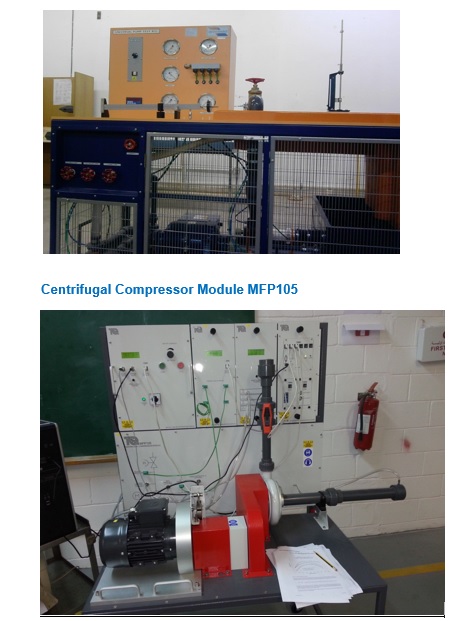
The TQ centrifugal compressor module MFP105 Allows students to study and perform tests on a centrifugal compressor: to-understand how it works and calculate its performance.
Instruments and Measurements include, Pressures: Piezoelectric transducers and digital display, Flow rate: Nozzle and pressure transducer, Torque, speed and power: Measured and displayed digitally by the Universal Dynamometer (MFP100), Temperatures: K-type thermocouples and digital display
Experiments:
- Performance of a compressor
- Variation of compressor performance with speed
- Investigation of non-dimensional characteristics
- Comparison of performance with that of an ideal adiabatic system
The TQ centrifugal fan module MFP106 Allows students to study and perform tests on a centrifugal fan: to understand how it works and calculate its performance. Impellers: Forward Swept, Backward Swept and Radial, Pressures: Piezoelectric transducers and digital display, Flow rate: Nozzle and differential pressure transducer, Torque, speed and power: Measured and displayed, digitally by the Universal Dynamometer (MFP100)
Experiments:
- Performance of a centrifugal fan
- Variation of fan performance with speed
- Variation of fan performance with type of impeller
- Non-dimensional performance curves
- Determination of the specific speed of the fa
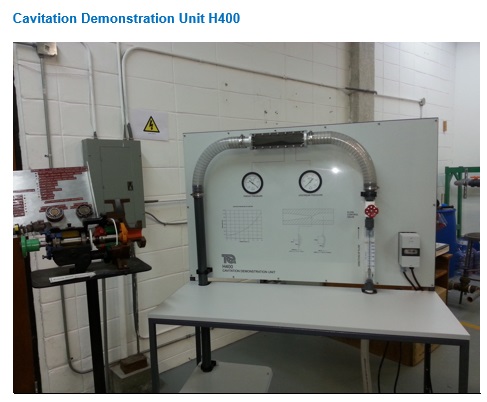
The TQ cavitation demonstration unit H400 offers a clear and easy to-understand display of cavitation. Students create clearly visible cavitation in a Venturi (which has a transparent window) and take measurements of flow and pressure. Students use theory and practical experiments to learn how to predict the onset of cavitation. They gain practical experience of using the continuity equation and Bernoulli's equation.
Experiments:
- Flow and pressure in the Venturi
- Demonstrations of cavitation
- How to predict the onset of cavitation
The Armfield capture units:
Centrifugal Fan FM10. Centrifugal Compressor FM12. Centrifugal pumps FM20. Gear Pump FM 22. Plunger Pump FM23.
All of these equipments are designed to allow students to determine the operating characteristics of each of the above mentioned turbomachines rapidly and meaningfully, using on-line data acquisition and analysis. Test results may be displayed in tabular and graphical forms, and it is a simple matter to repeat or add to the data to cover areas of the machine performance of particular interest.
Centrifugal Pump Demonstration Unit FM 20
It is a small-scale centrifugal pump demonstration unit, comprising of a water reservoir, the pump, control valves and interconnecting pipe work all mounted on a stainless steel base. The unit is equipped with electronic measurement sensors for pump head pressure, suction, flow-rate and water temperature and capable of being linked to a PC.
The unit is used to demonstrate:
- The operation of a single-stage centrifugal water pump.
- Measurement of pump characteristic curves.
- Pump total head.
- Motor shaft power.
- Impeller speed.
- Pump efficiency.
- Introduction to pump speed laws.
- Investigation of impeller styles.
- Comparison of student calculations with computer results.
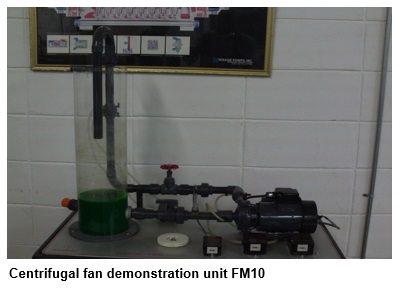
It is a small-scale centrifugal fan demonstration unit, comprising of an inlet duct, the fan, an outlet duct and an adjustable aperture, all mounted on a stainless steel base. The unit is equipped with electronic measurement sensors for fan head pressure, flow-rate (via orifice plate) and air temperature and it is capable of being linked to a PC.
The unit is used to demonstrate:
- Measurement of constant-speed machine performance in terms of static and total pressures, rotor speed and motor shaft power, as a function of inlet flow.
- Measurement of fan efficiency and estimation of impeller power efficiency.
- Measurement of performance at constant speeds.
- Introduction to similarity laws for scale-up.
- Comparison of student calculations with computer results.
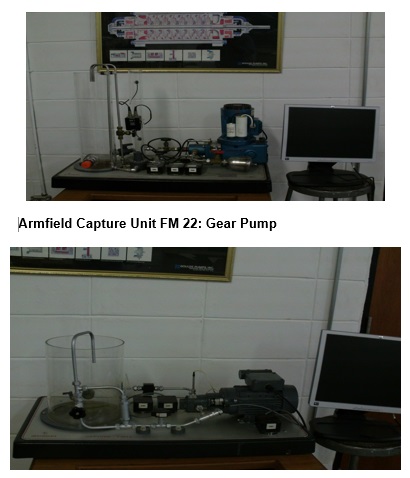
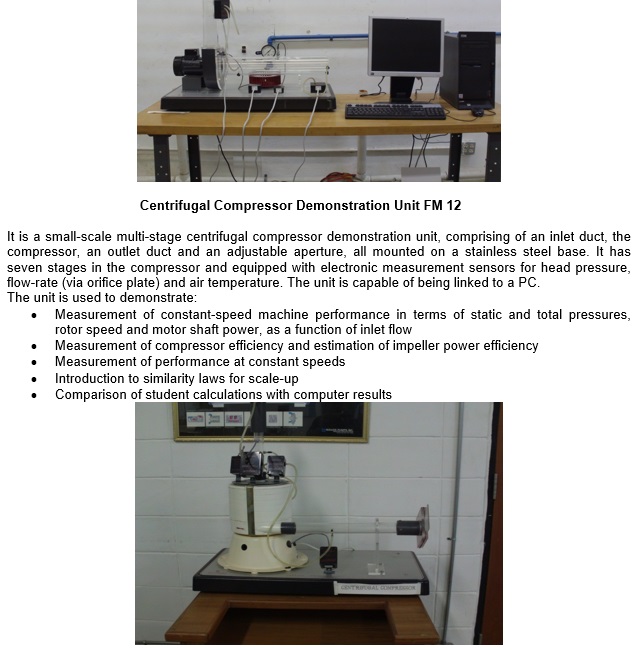
The Armfield Compressible Flow Bench
This is an experimental test rig that is equipped with a multi-stage centrifugal compressor driven by a variable-speed motor. Besides the capabilities of studying the compressor performance characteristics, the apparatus is provided with several attachments for investigating flow in an orifice, friction losses in bends, friction losses in compressible pipe flow and flow in sudden pipe enlargements.
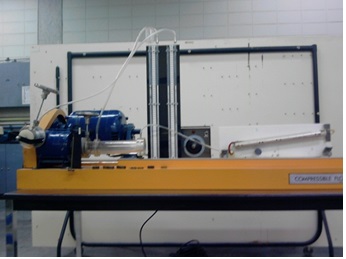
Updated: October 2015